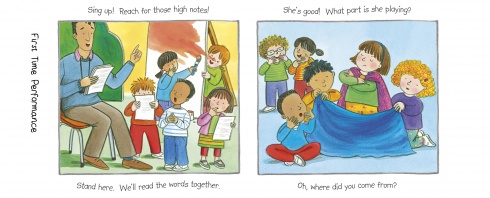
With these exercises, students will learn new words and review vocabulary related to "First Time" and "Helping Hands" experiences. They will closely examine the text and illustrations to identify the setting, theme and major events. They will participate in large and small group discussions, providing evidence gleaned from the stories to support their reasoning. And, finally, they will synthesize all they've learned from previous activities to collaborate on a class book featuring an idea for a new title in the "First Time" or "Helping Hands" series.
Pre-Reading Discussion Questions
Examine the front cover. Read the title of the book and discuss with children what activity or event will be the focus of the book. For the "First Time" books, discuss whether children have ever experienced this "First Time" themselves. What was it like? How did they feel about it? Or, if not, what questions do they have about it? For the "Helping Hands" books, how do children help their families around the house? How do they help out in the classroom? Do they have tasks or chores they regularly do?
Do a Picture Walk, closely examining each illustration. What do children think is happening? Encourage students to predict the story by looking at the illustrations.
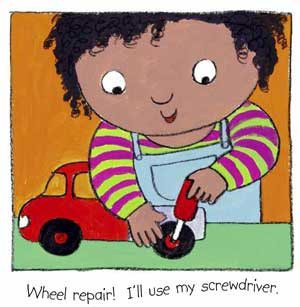
Post-Reading Discussion Questions and Activities
Vocabulary
Review the story and identify any unfamiliar words or phrases. Work with students to define them using context and the illustrations. As a class make a "word wall" for the book by listing words related to this "First Time" or "Helping Hands" experience, including any new words children learned from this book. Have each child make a single drawing that illustrates as many of these words as possible.
RL/RI K.4
L K.4, K.6
Discussion Starters
Look at one of the "First Time" books. Ask students: What is the new experience featured in this book? Where does it take place? When does this thing happen for the first time? Is this experience something you participate in (like performing on stage), or is it something that happens to you (like going to dentist)? What is the best part of this experience? What is the worst part? What did you learn about this experience from this book? Be sure they cite specifics from the text and illustrations to support their opinions.
Look at one of the "Helping Hands" books. Ask students: What are the children helping to do in this book? Where does it take place? Make a list of the different tasks presented in the book. Do the tasks need to be done in a certain sequence? Are there any precautions one needs to take to be safe? Do you need certain tools or skills? What's the best thing about helping with this task? What's the worst thing? What's the importance of doing this task? Remind students to use evidence from the book when answering.
RL/RI K.1, K.2, K.3, K.7, K.10
SL K.1, K.2
Drawing a Picture
These picture books do a great job of using illustrations to tell a story in a way that will be meaningful to young children. Discuss with children the role of the author and of the illustrator in telling the story. What do the illustrations tell the reader about the story's characters, setting and events? What elements of the illustrations does the text reinforce? What else is going on in the illustrations? How do these details reinforce the main theme of the story?
RL/RI K.1, K.3, K.6, K.7
SL K.1, K.2
The Big Event
After reading the book to the class, have them list the major events that take place. Review this summary as a class. What information did children already know? What was the most surprising thing they learned from the book? What was the most interesting? Do these events always take place in the same order? Is there any additional information they would share with other children about this activity? Do they have any additional questions about the experience in the book?
Optional: Make a list of these additional ideas and have each student select one to illustrate as an additional page of this book. When the drawings are done, have students dictate accompanying text to an adult. Display these new pages in the classroom.
RL/RI K.1, K.2, K.3, K.7
SL K.1, K.2, K.3, K.5
W K.3
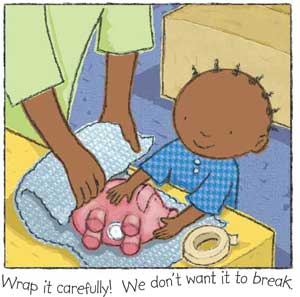
A Picture Is Worth 1000 Words
Break children into pairs or small groups and assign each group a two-page spread of the book for closer study. Working with an adult if necessary, have students familiarize themselves with the text and study the pictures. Then, have each group present the story of what is going on in their illustrations to the rest of the class. Have them point out details and show how the text and the pictures work together to tell the story. What information did they learn about this experience? Have each pair or group make up additional dialogue that would be appropriate for their illustrations.
RL/RI K.1, K.2, K.3, K.7
SL K.1, K.2, K.4, K.5, K.6
Apples to Apples
Read a few books from the series as a class. Come together as a group and discuss how the books are the same and how they are different. Be sure to look at both the pictures and the text. Is one book a favorite, or are they all equally interesting? Which one seems the most educational? The most informative? Can students come up with any other ideas that would fit in the series?
RL/RI K.1, K.3, K.7, K.9
SL K.1, K.2
Punctuation
With their emphasis on questions, answers, exclamations and statements, these books are a perfect way to review punctuation with children. Give every child three cards: one with a question mark, one with a period and one with an exclamation point. Copy out sentences from the book onto the blackboard that have different ending punctuations, but do not include the punctuation mark. Read the sentence aloud and have children hold up the card that has the proper ending punctuation. Now choose a volunteer to say the sentence aloud with the proper inflection and explain why they chose the punctuation they did.
L K.2
"First Time" Feelings
When people are experiencing things for the first time, they go through many emotions: fear, excitement, surprise, joy and more. The books in this series capture the spectrum of feelings associated with these new experiences. After reading the story with the group, go through it a second time and draw attention to the illustrations and text that convey feelings. Create a class list of the different feelings expressed by characters in the story and provide evidence from the text and illustrations that show these emotions.
RL/RI K.1, K.7
SL K.1, K.2
"Helping Hands" Helping Each Other
There are opportunities in everyday life to imitate the behavior from the "Helping Hands" books. Have children select one of the books that focuses on tasks or projects they see happening in their family - like shopping, or gardening, or recycling. Have the student list the steps involved in this activity and how they can participate in it. Coordinate with parents or other adults at home so the child can lend a "Helping Hand." After they have completed the project have the children report back to the class about what happened. How was the experience similar to what happened in the book? How was it different?
RL/RI K.1, K.2, K.7
SL K.1, K.2, K.4, K.6
Make Your Own
Once students have read the "First Time" or "Helping Hands" books, have the class brainstorm ideas for a new title in the series. After the class has settled on a topic for the book, create a list of words that relate to the experience they have chosen. Then explore the topic further by discussing the following questions: What kinds of things might happen during this "Helping Hands" or "First Time" experience? What questions might readers have? What might they be concerned about? What might surprise them? What will they like best? Is there anything they might be afraid of? Must this activity be done in a certain order? As a class, finalize the ideas to include in the book. Assign one to each child for illustration, using the same layout that the books use: A picture with conversational text above and below it. Working with an adult have the child compose the text to go on the page in the style of the book. When the class is done, assemble the new book and have them do a live reading of it. Scan the pages into the computer and send copies - electronic or paper - home with each child.
RL/RI K.1, K.10
W K.2, K.3, K.6, K.7
SL K.1, K.3, K.4, K.5, K.6
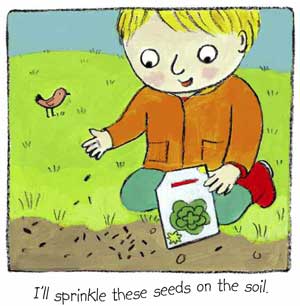
Visit the Common Core State Standards website to read about the individual standards:
http://www.corestandards.org/read-the-standards/
 Go to UK site
Go to UK site Go to AUS site
Go to AUS site
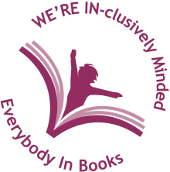
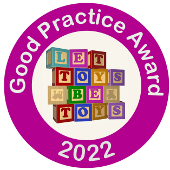
Email this page to a friend